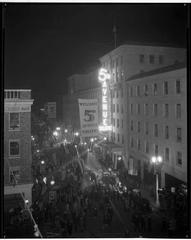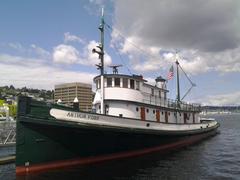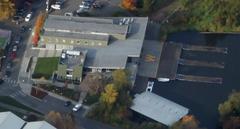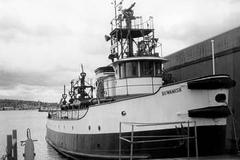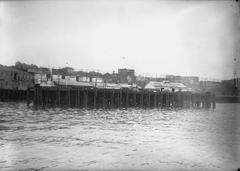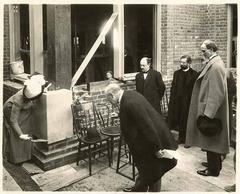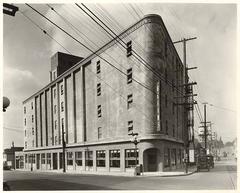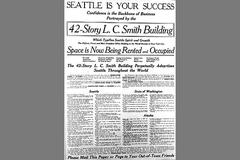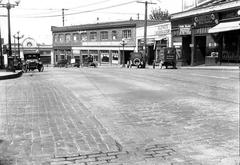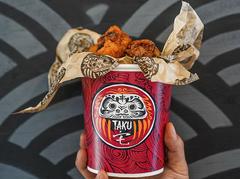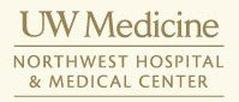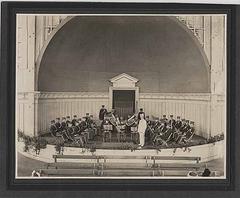
Red Square Seattle Visiting Hours, Tickets, and Historical Sites Guide
Last Updated: 04/07/2025
Introduction: Red Square’s History and Significance
Red Square is the symbolic and physical heart of the University of Washington (UW) in Seattle—a place where history, architecture, and campus culture converge. Renowned for its iconic red brick paving, Red Square not only connects key academic buildings but also serves as a vibrant gathering place for students, faculty, visitors, and Seattle locals alike. Its story stretches from the indigenous Coast Salish peoples who originally inhabited the land, through its role in the 1909 Alaska-Yukon-Pacific Exposition, to its transformation into a modernist plaza atop an innovative underground parking structure. Today, Red Square is a hub of campus life, activism, and public art, framed by architectural landmarks and seasonal highlights like the famous cherry blossoms in the Quad.
Open year-round with no admission fee, Red Square is accessible to all, featuring ramps and smooth pathways. The plaza hosts a rich array of events—academic ceremonies, cultural festivals, protests, and public gatherings—reflecting Seattle’s multicultural fabric and progressive spirit. This comprehensive guide offers essential insights, practical travel tips, and historical context for anyone planning to visit Red Square, explore Seattle historical sites, or experience the dynamic culture of the University of Washington.
For further details and up-to-date visitor resources, see the University of Washington Visitor Center, Seattle Met’s guide to UW Cherry Blossoms, and the UW Campus Landscape Framework Plan.
Table of Contents
- Introduction
- Early Origins and Pre-Red Square History
- Transformation into a Central Campus Plaza
- Architectural and Spatial Features
- Red Square as a Center of Campus Life
- Notable Features and Artworks
- Visiting Red Square: Hours, Accessibility, and Tips
- Ongoing Evolution and Future Plans
- Timeline of Key Developments
- Frequently Asked Questions (FAQ)
- Conclusion
- References
Early Origins and Pre-Red Square History
Red Square sits on the traditional lands of the Coast Salish peoples, including the Duwamish Tribe. Long before the university’s expansion, this area was shaped by indigenous stewardship. In 1909, the site took center stage during the Alaska-Yukon-Pacific Exposition—a world’s fair that positioned Seattle as a gateway to Alaska and the Pacific Rim. A temporary U.S. Government Building was constructed here for the event (larchbu.be.uw.edu). After the fair, the area became an open field, later known as the Suzzallo Quadrangle.
Transformation into a Central Campus Plaza
20th Century Campus Planning
The UW campus underwent significant growth throughout the 20th century. The area now known as Red Square was gradually defined by the construction of Suzzallo Library (1926), Gerberding Hall (1949), and Meany Hall (1954), forming the plaza’s architectural borders (larchbu.be.uw.edu).
By the 1960s, increased enrollment and the rise of car culture necessitated new infrastructure. In 1969, work began on a large underground parking garage beneath the quadrangle, an engineering feat that would ultimately influence the plaza’s design (larchbu.be.uw.edu).
The Birth of Red Square
To cover the new garage, architects led by Paul Hayden Kirk opted for a paved brick surface—both for its durability and to address drainage concerns. The design was inspired by Italy’s Piazza del Campo, aiming to create an open, democratic space for large gatherings (larchbu.be.uw.edu). Completed in 1971, the plaza’s red bricks gave rise to the name “Red Square,” which has also been a tongue-in-cheek nod to political activism during student protests (washington.edu).
Architectural and Spatial Features
Red Square is the intersection of five major campus pathways, making it both a literal and symbolic crossroads. It’s bordered by:
- Suzzallo and Allen Libraries (east): Collegiate Gothic landmarks
- Gerberding Hall (south)
- Kane Hall (north)
- Odegaard Undergraduate Library (west)
- Meany Hall for the Performing Arts (nearby)
The plaza’s open expanse supports pedestrian traffic and large events alike. Its red bricks are visually striking but can be slippery during Seattle’s rainy seasons (washington.edu). Three brick monoliths (ventilation shafts) punctuate the space, echoing Tuscan campaniles and serving as sculptural features (Wikipedia; SAH Archipedia).
Red Square as a Center of Campus Life
Gatherings, Events, and Celebrations
Red Square hosts a diverse range of campus and community activities—information booths, cultural fairs, outdoor classes, performances, and university traditions like “Dog Dayz” and Husky rallies (larchbu.be.uw.edu).
Site of Activism and Public Expression
Since the 1970s, Red Square has been a focal point for activism, from antiwar protests to vigils and rallies on contemporary issues (larchbu.be.uw.edu; reddit.com). The space’s openness supports free expression while balancing campus safety and public order.
Notable Features and Artworks
- Barnett Newman’s “Broken Obelisk”: A 26-foot Cor-Ten steel sculpture, installed in 1971, symbolizing aspiration and rupture (SAH Archipedia).
- George Washington Statue: A 1909 bronze, anchoring the plaza historically and visually (Wikipedia).
- Rainier Vista: Steps lead visitors to Drumheller Fountain and provide dramatic sightlines to Mount Rainier (Wikipedia).
Visiting Red Square: Hours, Accessibility, and Tips
- Visiting Hours: Open to the public 24/7, year-round.
- Admission: Free, no tickets required.
- Accessibility: Wheelchair-accessible with ramps and smooth pathways; adjacent buildings have accessible restrooms.
- Getting There: Served by King County Metro buses and U District Link Light Rail station (SDOT Blog). Bike racks and pedestrian pathways are plentiful.
- Parking: Underground Central Plaza Garage (cashless payment), Padelford Garage, and surface lots (early arrival recommended during events and cherry blossom season) (FOX 13 Seattle).
- Tours: Guided campus tours (including Red Square) are available via the UW Visitor Center.
- Photography: Best spots include the Suzzallo Library façade, cherry blossoms in the Quad, and the plaza’s public art. Early morning and late afternoon offer optimal lighting.
- Etiquette: Respect ongoing events, avoid climbing on trees or art, and observe campus policies regarding pets (service animals only).
Ongoing Evolution and Future Plans
The UW Campus Landscape Framework Plan outlines ongoing improvements to Red Square—focusing on enhancing safety, accessibility, and the visitor experience while preserving the plaza’s historic and architectural integrity.
Timeline of Key Developments
- 1909: U.S. Government Building erected for Alaska-Yukon-Pacific Exposition (larchbu.be.uw.edu).
- 1926–1954: Suzzallo Library, Gerberding Hall, and Meany Hall constructed.
- 1969: Construction begins on the underground garage and plaza.
- 1971: Completion of Red Square and installation of “Broken Obelisk.”
- 1970s–Present: Red Square becomes a hub for campus life, activism, and events.
- 2015: Landscape Framework Plan recommends further enhancements.
Frequently Asked Questions (FAQ)
Q: What are Red Square’s visiting hours?
A: Open 24/7, year-round, with no admission fee.
Q: Is a ticket required to enter Red Square?
A: No, it is free and open to the public.
Q: Are guided tours available?
A: Yes, through the UW Visitor Center.
Q: Is Red Square wheelchair accessible?
A: Yes, with ramps, smooth paving, and accessible facilities nearby.
Q: What’s the best time to visit Red Square?
A: Spring for cherry blossoms (mid-March to early April), graduation season in June, and during major campus events. Weekday mornings are less crowded.
Q: Can I park on campus?
A: Yes, but spaces are limited and paid. Use public transit or arrive early during peak times.
Q: Can I bring pets?
A: Only service animals are allowed.
Q: Are there good spots for photography?
A: Yes—Suzzallo Library, cherry blossoms, public art, and panoramic plaza views.
Practical Tips for a Memorable Visit
- Arrive Early During Peak Season: Especially for cherry blossoms.
- Use Public Transit: To avoid parking hassles (SDOT Blog).
- Dress for Weather: Bring rain gear and wear comfortable shoes.
- Respect the Environment: Do not touch or climb cherry trees; pack out your trash.
- Stay Updated: Monitor UW’s cherry blossom webcam and social media for bloom and crowd info.
- Prepare for Cashless Transactions: Parking and most campus purchases require card or mobile payment.
Conclusion: Experience the Heart of Seattle’s Campus
Red Square is more than a brick-paved plaza—it is a living emblem of Seattle’s academic excellence, cultural diversity, and civic spirit. Its evolving landscape, historic architecture, and dynamic energy make it a must-visit for anyone exploring the city or UW campus. From the iconic cherry blossoms to public art and student events, Red Square offers something for every visitor.
For the latest visitor information, download the Audiala app or visit the UW Visitor Center website. Follow our social media channels for updates on events, campus news, and travel tips.
References
- Exploring Red Square at University of Washington: History, Visitor Info, and Campus Life, 2019, University of Washington (larchbu.be.uw.edu)
- Red Square University of Washington: Visiting Hours, Tickets & Seattle Historical Sites, 2024, SAH Archipedia & Atomic Ranch (sah-archipedia.org)
- Red Square Visiting Hours and Cultural Guide to Seattle’s Historic UW Plaza, 2024, University of Washington (washington.edu)
- Visitor Experience and Practical Tips, 2025, Seattle Met & FOX 13 Seattle (seattlemet.com)
- UW Cherry Blossoms 2024, 2024, University of Washington News (washington.edu)
- Seattle Culture & Traditions, 2024, Overyourplace (overyourplace.com)
- SDOT Blog – UW Cherry Blossom Festival Travel, 2025, Seattle Department of Transportation (sdotblog.seattle.gov)
- FOX 13 Seattle – UW Cherry Blossoms, 2025, FOX 13 Seattle (fox13seattle.com)
- Wikipedia – Red Square (University of Washington), 2024 (en.wikipedia.org)
- Reddit – Candlelit Vigil at UW Red Square, 2022 (reddit.com)

